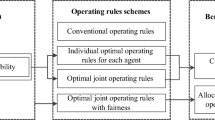Abstract
Given the institutional limitations of multi-stakeholders, exploring the synergistic revenue from the joint reservoir operations of a multi-stakeholder multi-reservoir system requires a synergistic revenue allocation mechanism to ensure a beneficial solution for multi stakeholders. This study established a synergistic revenue allocation model using bargaining game theory under the principles of equity, rationality, and efficiency. For the maximization the Nash product of gains in the utility of stakeholders and constraints on the feasibility of allocation plans considering all the possible formations of sub-coalitions, the analytic optimal solution of the bargaining model was derived using the first-order optimality condition. The optimal revenue allocation plan meets the conditions of the equal quasi-marginal utility function among stakeholders. The methodologies were applied to a hypothetical cascade reservoir system operated by multiple stakeholders. Compared with the revenue allocation plans obtained by a proportional rule method and the Shapley value method, the results corroborate that (1) the allocation plan of the bargaining model is jointly determined by the interval of the revenue range of each reservoir and the effectiveness of the sub-coalition constraints, indicating that the allocated synergistic revenue is positively correlated with the singleton contribution and team contribution on the total revenue of the grand coalition; (2) the difference in the plans obtained by the three methods is generally determined by the difference in equity definition; and (3) the synergistic revenue allocation plan obtained from the bargaining model is the highest homogenized among all reservoirs (stakeholders), which demonstrates that the revenue of those dominated stakeholders can be improved compared with other plans. The proposed methodologies provide new insights to guide benefit share decisions in multi-stakeholder reservoirs system.





Similar content being viewed by others
References
Arrow KJ (1965). Aspects of the theory of risk-bearing. Yrjö Jahnssonin Säätiö
Cheng C, Li S, Li G (2014) A hybrid method of incorporating extended priority list into equal incremental principle for energy-saving generation dispatch of thermal power systems. Energy 64:688–696. https://doi.org/10.1016/j.energy.2013.10.044
Ganji A, Khalili D, Karamouz M (2007) Development of stochastic dynamic Nash game model for reservoir operation. I. The symmetric stochastic model with perfect information. Adv Water Resour 30(3):528–542. https://doi.org/10.1016/j.advwatres.2006.04.004 (in Chinese)
Gao S, Tao Z, Yang R (2007) The study of entropy-weighting method on apportion the compensation benefit of cascaded hydropower stations. Water Resource and Power 25(4):120–122
Girard C, Rinaudo J, Pulido-Velazquez M (2016) Sharing the cost of river basin adaptation portfolios to climate change: insights from social justice and cooperative game theory. Water Resour Res 52(10):7945–7962. https://doi.org/10.1002/2016WR018757
Harsanyi J (1959) A bargaining model for the cooperative n-person game in: contributions to the theory of games 4. Princeton University Press, Princeton
Herman JD, Zeff HB, Reed PM, Characklis GW (2014) Beyond optimality: multistakeholder robustness tradeoffs for regional water portfolio planning under deep uncertainty. Water Resour Res 50(10):7692–7713. https://doi.org/10.1002/2014WR015338
Huang H, Yan Z (2009) Present situation and future prospect of hydropower in China. Renew Sust Energ Rev 13(6–7):1652–1656. https://doi.org/10.1016/j.rser.2008.08.013
Madani K (2011) Hydropower licensing and climate change: insights from cooperative game theory. Adv Water Resour 34(2):174–183. https://doi.org/10.1016/j.advwatres.2010.10.003
Madani K, Hooshyar M (2014) A game theory–reinforcement learning (GT–RL) method to develop optimal operation policies for multi-operator reservoir systems. J Hydrol 519:732–742. https://doi.org/10.1016/j.jhydrol.2014.07.061
McKinney DC, Teasley RL. (2007). Cooperative Game Theory for Transboundary River Basins: The Syr Darya Basin. Paper presented at the World Environmental and Water Resources Congress 2007: Restoring Our Natural Habitat
Mianabadi H, Mostert E, Pande S, van de Giesen N (2015) Weighted bankruptcy rules and transboundary water resources allocation. Water Resour Manag 29(7):2303–2321. https://doi.org/10.1007/s11269-015-0942-x
Ming Z, Song X, Mingjuan M, Xiaoli Z (2013) New energy bases and sustainable development in China: a review. Renew Sust Energ Rev 20:169–185. https://doi.org/10.1016/j.rser.2012.11.067
Nash J (1953) Two-person cooperative games. Econometrica 21:128–140
Pérez-Blanco CD, Gutiérrez-Martín C (2017) Buy me a river: use of multi-attribute non-linear utility functions to address overcompensation in agricultural water buyback. Agr Water Manage 190:6–20. https://doi.org/10.1016/j.agwat.2017.05.006
Shapley LS (1953) A value for n-persons games. Ann Math Stud 28:307–318
Skardi MJE, Afshar A, Solis SS (2013) Simulation-optimization model for non-point source pollution management in watersheds: application of cooperative game theory. KSCE J Civ Eng 17(6):1232–1240. https://doi.org/10.1007/s12205-013-0077-7
Takayama A. (1993). Analytical methods in economics: University of Michigan Press
Xu B, Zhong P, Zambon RC, Zhao Y, Yeh WWG (2015) Scenario tree reduction in stochastic programming with recourse for hydropower operations. Water Resour Res 51(8):6359–6380. https://doi.org/10.1002/2014WR016828
Xu B, Boyce SE, Zhang Y, Liu Q, Guo L, Zhong P (2017a) Stochastic programming with a joint chance constraint model for reservoir refill operation considering flood risk. J Water Res Plan Man 143(1):4016067. https://doi.org/10.1061/(ASCE)WR.1943-5452.0000715
Xu B, Zhong P, Wu Y, Fu F, Chen Y, Zhao Y (2017b) A multiobjective stochastic programming model for hydropower hedging operations under inexact information. Water Resour Manag 31(14):4649–4667. https://doi.org/10.1007/s11269-017-1771-x
Yu Z, Pollard D, Cheng L (2006) On continental-scale hydrologic simulations with a coupled hydrologic model. J Hydrol 331(1–2):110–124. https://doi.org/10.1016/j.jhydrol.2006.05.021
Zhao T, Zhao J, Lund JR, Yang D (2014) Optimal hedging rules for reservoir flood operation from forecast uncertainties. J Water Res Plan Man 140(12):4014041. https://doi.org/10.1061/(ASCE)WR.1943-5452.0000432
Acknowledgements
We would like to thank two anonymous reviewers for their in-depth reviews and constructive suggestions. The remarks and summary of reviewer comments provided by the Editor and Associate Editor are also greatly appreciated, which have facilitated major improvements in this paper. The authors are grateful to Dr. Yenan Wu for the help on revising the manuscript.
This study is supported by the National Key Technologies R&D Program of China (Grant No. 2017YFC0405604), the National Natural Science Foundation of China (Grant No. 51609062), the Fundamental Research Funds for the Central Universities (Grant No.2018B10514), and the China Postdoctoral Science Foundation Funded Project (Grant No. 2018T110525).
Author information
Authors and Affiliations
Corresponding author
Ethics declarations
Conflict of Interest
None.
Rights and permissions
About this article
Cite this article
Xu, B., Ma, Y., Zhong, Pa. et al. Bargaining Model of Synergistic Revenue Allocation for the Joint Operations of a Multi-Stakeholder Cascade Reservoir System. Water Resour Manage 32, 4625–4642 (2018). https://doi.org/10.1007/s11269-018-2075-5
Received:
Accepted:
Published:
Issue Date:
DOI: https://doi.org/10.1007/s11269-018-2075-5




